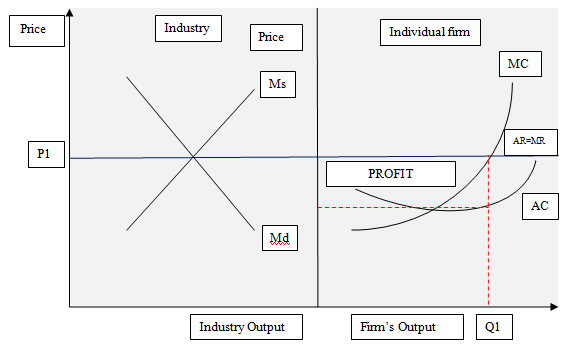
Pure monopoly refers to a situation where there is only one firm offering a specific type of product or service. However, instances of pure monopoly are very rare in modern markets due to the intensified level of globalisation of economies and anti-monopoly rules and regulations introduced by governments. Working monopoly refers to a situation where any company possesses more than one fourth of the market share. Certain firms are able to attain monopoly in the market due to possession of scare resources, special government grants under certain circumstances, possession of patents for innovations or as a result of merger of two or more large companies in the industry. Achievement of profit maximisation objective is easier by monopolistic firms compared to other market structure due to the lack of competition. In simple terms, consumers have no choice but to purchase products offered by monopolist firm due to the lack or even absence of alternative products in the market. Price discrimination can be divided into three categories: first degree, second degree, and third degree. First degree price discrimination is associated with inelastic markets where a certain business entity is in the position of pricing its products at different levels, at the same time selling to the whole market without competition, which is rare in practical levels. As it is illustrated in figure below, second degree price discrimination relates to elastic market where businesses offer different amounts of their products for different prices. Lastly, the third degree of price discrimination marks the case of combined market where different prices are set for different groups of consumers. Businesses can engage in price discrimination only if they possess certain degree of monopoly. In other words, monopolistic businesses use price discrimination strategies in order to increase the levels of abnormal profits. The degree of price discrimination…

Perfect competition can be defined as a situation “in an industry when that industry is made up of many small firms producing homogeneous products, when there is no impediment to the entry or exit of firms, and when full information is available” (Baumon and Blinder, 2011, p.200). Market structure can be specified as perfect competition if the following conditions or assumptions are met: Firstly, there are many supplies in the market and each supplier has an insignificant market share. In other words, no single supplier is in the position of impacting price through manipulations with its supply of products. Secondly, there are no major differences between products offered by suppliers and these products can be consumed as substitution for each-other. To be more specific, even when there are certain differences between products in the same industry, they are identical in consumer perception. Thirdly, consumers are fully aware about costs charged by all suppliers. This situation has implications in a way that a certain supplier decides to increase its prices; the levels of its revenues will decline because of consumers switching to other suppliers. Fourthly, the level of access to various resources is equal for all suppliers. Moreover, all participants in the industry can benefit from breakthroughs and other positive changes in the industry in an equal manner. Fifthly, industry entry and exit barriers for suppliers are insignificant. In other words, new suppliers can join competition at any time with implications on the levels of profits of existing suppliers. Sixthly, there is no divergence between private costs and social costs, as well as, benefits due to the absence of externality in manufacturing and consumption. Six main assumptions associated with perfect competition market structure discussed above have certain implications on profit maximisation attempts of businesses. Outcome of interaction between supply and demand…

Burke (2012) links the impacts of the global economic crisis of 2008-2010 with spending cuts on education system by the UK government. Chalabi and Arnett (2013), on the other hand, make an interesting observation related to the issue. Specifically, according to Chalabi and Arnett (2013), the levels of GDP in the UK decreased by 2 per cent between 2008 and 2010, whereas the levels of public expenditure on education have increased by 8 per cent during the same period. A large-scale survey conducted by Education Institution (2009) has attempted to assess impacts of the global economic crisis on education in 48 countries, including the UK. Infrastructure, human resources (HR), and other needs of the UK education system have been found as a result of the survey. Infrastructure needs of UK education system, according to Education Institution (2009) relates to necessity to rebuilt primary schools. Other needs are found to relate to funding for high quality continuing professional development of teachers and challenges associated with reforming curriculum and qualification system. However, it is important to note that Education Institution (2009) findings only relate to education in public sector, and the level of relevance of data to private sector educational institutions are yet to be established. Burke (2012) considers dramatic reduction of numbers of graduate employment schemes offered by multinational companies in 2009 as the direct impact of the global economic crisis. Although, this argument appears to be convincing, Burke (2012) fails to back-up the claim through referring to relevant statistical data. Vaitilingam (2010) points to the risk of lifetime earning loss for a generation of graduates that join full-time workforce during or immediate aftermath of recession. According to Vaitilingam (2010), this situation may occur due to rapid increase in the supply of graduates compared to jobs caused by cuts on graduate…

National economy of the UK entered the period of recession on the fourth quarter of 2008. Review of literature has found consensus amongst authors about significant negative impacts of the global economic crisis of 2008-2010 on UK economy. The lowest level of recession in UK occurred in June 2009, when the decline of economy has amounted to 5.5 per cent compared to its peak in Quarter 1, 2008 (Vaitilingam, 2010). According to Bell and Blanchflower (2011), the crisis has resulted in substantial cuts on government spending, reduction on the levels of household spending, and has contributed to the emergence of uncertain and volatile investment climate. Impacts of the crisis on jobs in the UK have been analysed by Vaitilingam (2010) in a detailed manner. To be more specific, Vaitilingam (2010) assesses job-related impacts of the global economic crisis of 2008-2010 to include increase on the levels of unemployment and regional disparities in Britain’s economic geography. Additionally, Vaitilingam (2010) specifies low-educated and low-skilled employees, as well as, older workers to be most disadvantaged in terms of being negatively impacted from the crisis. Sobel (2012) draws attention to personal and emotional implications of the crisis to daily lives of people in the UK and elsewhere. According to Sobel (2012) due attention is not paid to this specific aspect of the crisis and the authors stresses the necessity for additional researches in this area. References Bell, D.N. & Blanchflower, D.G. (2011) “The crisis, policy reactions and attitudes to globalisation and jobs” WTO Sobel, A.C. (2012) “Birth of Hegemony: Crisis, Financial Revolution, and Emerging Global Networks” University of Chicago Press Vaitilingam, R. (2010) “Recession Britain: Findings from economic and social research” Economic & Research Council

There is a large volume of published studies analysing major reasons of the global economic crisis of 2008-2010. Excessive risk taking by financial institutions in the US combined with inefficiencies with US housing regulations is shown as primary causes of global recession by Roberts (2009) and Heng (2010). Heng (2010) offers detailed account of the issue and effectively demonstrates that US-based financial institutions have encouraged individuals with no adequate credit history to own homes and rapid decline of house prices, phenomenon known as ‘housing bubble’ has given start to a severe global financial and economic crisis. A study conducted by Sobel (2012) confirms excessive risk taking and inefficiencies with housing regulations as reasons behind the economic crisis and also discussed additional factors not mentioned by many other authors. Specifically, according to Sobel (2012), inadequacies in formulating interest rate policies, as well as, policies to suppress inflation in the US have also played major role in creation of environment that led to the global economic crisis of 2008-2010. Globalisation is perceived by Tan (2010) as one of the major enabling factors of the global economic crisis of 2008-2010. The topic of globalisation is addressed by Samson and Daft (2012) in great details. Specifically, Samson and Daft (2012) divide globalisation into four stages and cultural sensitivity and managerial assumptions in each stage in the following manner: 1. Domestic 2. International 3. Multinational 4. Global Strategic orientation Domestically oriented Export-oriented, multi-domestic Multinational Global Stage of development Initial foreign involvement Competitive positioning Exposition of international operations Global Cultural sensitivity Of little importance Very important Somew hat important Critically important Manager assumptions ‘one best way’ ‘many good ways’ ‘the least-cost way’ ‘many good ways’ Four stages of globalisation Source: Samson and Daft (2012) However, while linking financial crisis and globalisation, Tan (2010) fails to…

Due to individual differences on the basis of cultural background, learning styles, personality etc. emergence of conflicts amongst employees in various levels is inevitable. Moreover, managerial expectations, communication breakdown and accountability issues can be specified as additional sources of conflict. Stereotyping can be mentioned as another factor that can cause conflicts in workplaces. Interestingly, the same elements that are perceived to be success factors such as team-working and communication can be sources of conflict due to reasons specified above. Constructive debates and conflicts may benefit organisation to a certain extent. To be more specific, conflicts may result in clarifications of certain issues, contribute to more effective decision-making and improve certain organisational processes. Nevertheless, managers need to ensure that occasional conflicts in organisation are limited within the boundary of work-related issues and employees do not conflict with each-other on personal grounds. Negative outcomes of conflicts may include stress, decreased employee performance, game of politics in organisation etc. Range of measures to be initiated by managers that can reduce the numbers and scope of unnecessary conflicts include fully clarifying roles and responsibilities of each individual employee, making management expectations clear, eliminating communication barriers with their subordinates and improving the overall organisational culture.
By John Dudovskiy
Category: Consumer Behaviour

The impact of time management in individual and team performance is great. Time is one of the most valuable resources of individuals and organisations and this resource needs to be dealt with accordingly. Penalties for neglecting the importance of time management for organisations include higher costs of operations and missed opportunities. Effective time management strategies for individuals include scheduling meetings and tasks in an organiser, compiling to-do lists, dealing with interruptions, eliminating distractions and others (Mathews et al., 2011, online). Time management strategies in organisational level, on the other hand, include developing Gant-Charts for the completion of important projects, imposing deadlines for each tasks, and organising virtual conferences that do not require physical presence of employees whenever possible. Moreover, some businesses have adopted an unconventional approach towards employee time management with positive effects on the bottom line. For example, one of the most famous internet companies of the present day – Google allows its employees to spend one fifth of their paid time on side projects and this strategy is often credited for the development of a range of successful Google services such as GMail and AdSense (Tate, 2013, online). References Mathews, J., Debolt, D. & Percival, D. (2011) “10 Time Management Tips that Work” Enterpreneur, Available at: http://www.entrepreneur.com/article/219553 Tate, R. (2013) “Google Couldn’t Kill 20 Percent Time Even if It Wanted To” Wired, Available at: http://www.wired.com/business/2013/08/20-percent-time-will-never-die/

Leadership can be explained as “the relationship in which one person influences others to work together willingly on a related task to attain goals by the leader or group” (Sekhar, 2010, p.46). Nowadays, the importance of leadership may be greater than ever before due to high levels of competition and increasing difficulty in sustaining competitive advantage. John Adair’s (2011) eight functions of leadership presented below have great impact on team effectiveness and therefore they need to be conducted appropriately: Defining the task. Tasks need to be defined according to SMART principle and this abbreviation is interpreted as specific, measurable, achievable, realistic and time-bound. Planning. Plans need to incorporate provision for unforeseen circumstances, which has become an evitable part of modern markets. Briefing. It is one of the most important responsibilities of a team leader to specify roles and responsibilities of each individual team member and clarify points of concern for team members during the briefing. Controlling and coordinating. This function needs to be conducted in a regular and systematic manner. Evaluating. It is important for evaluations to be conducted in an objective manner and team members should be provided with an honest feedback. Supporting. Leaders need to support the team with all necessary resources, as well as, guidance and advice in relation to critical aspects of team projects. Motivating. Effective application of tangible and intangible motivational tools can be justly specified as one of the critical success factors of efficient leadership. Tangible motivational tools to be offered to employees include cash and other forms of material benefits. Alternatively, intangible motivational tools may include formally or informally praising individual employees or teams for their contribution, organising celebrations of group achievements etc. Setting an example. Leaders to be become role models in expressing the role of importance of organisational values and adherence…

There are differences amongst employees in multiple levels and these differences do affect learning styles and capabilities of employees. This argument can be illustrated more effectively with the application of Honey and Mumford (1982) learning styles. According to this model learning can be divided into four different groups on the basis of individual preferences or styles: activists, theorists, pragmatists and reflectors. Activists include specific type of individuals who best learn by doing. Theorists, on the other hand, attempt to understand theoretical frameworks and they like to analyse core ideas behind the phenomenon to be learned. Pragmatists tend to be highly practical individuals, and accordingly unlike theorists pragmatists are interested in application of knowledge in real-life environment. Reflectors are observers who prefer to adopt a holistic approach towards the subject of learning. The model of Honey and Mumford learning styles has important practical implications in organisational settings. Senior level managers need to identify learning styles of key employees in order to be able to facilitate their learning more effectively. For example, employees with theorist learning style need to be assigned with tasks of analytical nature. Alternatively, individuals with advanced pragmatist learning styles need to be appointed in positions where problem-solving skills are prioritised. However, it has to be acknowledged that identification of learning styles of each individual employee is a challenging task and therefore this strategy needs to be applied only in relation to key members of the workforce. References Honey, P. & Mumford, A. (1982) “Manual of Learning Styles” London

Dictionary defines quality as the standard of something as compared to other things of a similar nature (Oxford Dictionaries, 2014, online), but quality is a subjective term to be used in practical levels. Three major elements of quality can be specified as quality planning, quality assurance and quality control and it is important for the Company to deal with each of these elements appropriately. Quality planning relates to identification of quality standards that needs to be adhered. Quality planning is engaged in before the process of manufacturing. Quality assurance, on the other hand, is associated with the measures and procedures that ensure adherence to standard quality and these measures and procedures are applied during the process of operations. Quality control refers to initiatives to be used to improve the quality of products and services. Quality-related tools and methods can be divided into two broad categories: quality enabling tools and quality measurement tools. Elements of both categories can be integrated in specific approaches or philosophies towards quality management. Total Quality Management (TQM) and Six Sigma are the most popular approaches to quality management. TQM stresses the importance of total commitment to quality throughout the organisation and its main principles include customer-orientation, leadership, strategic planning, continuous improvement, application of statistical methods, training and development and co-operation. Six Sigma is an alternative quality-related philosophy and it adopts a data-based approach to eliminate defects. General Electric defines Six Sigma as a vision for quality that is equal to only 3.4 defects per one million opportunities. Adoption of Six Sigma approach can offer a set of significant advantages such as significant improvement of quality, cost savings through elimination of wastes and reduction in manufacturing process cycle time, as well as uniting all members of operations workforce around the idea of quality priority. It is crucially…
